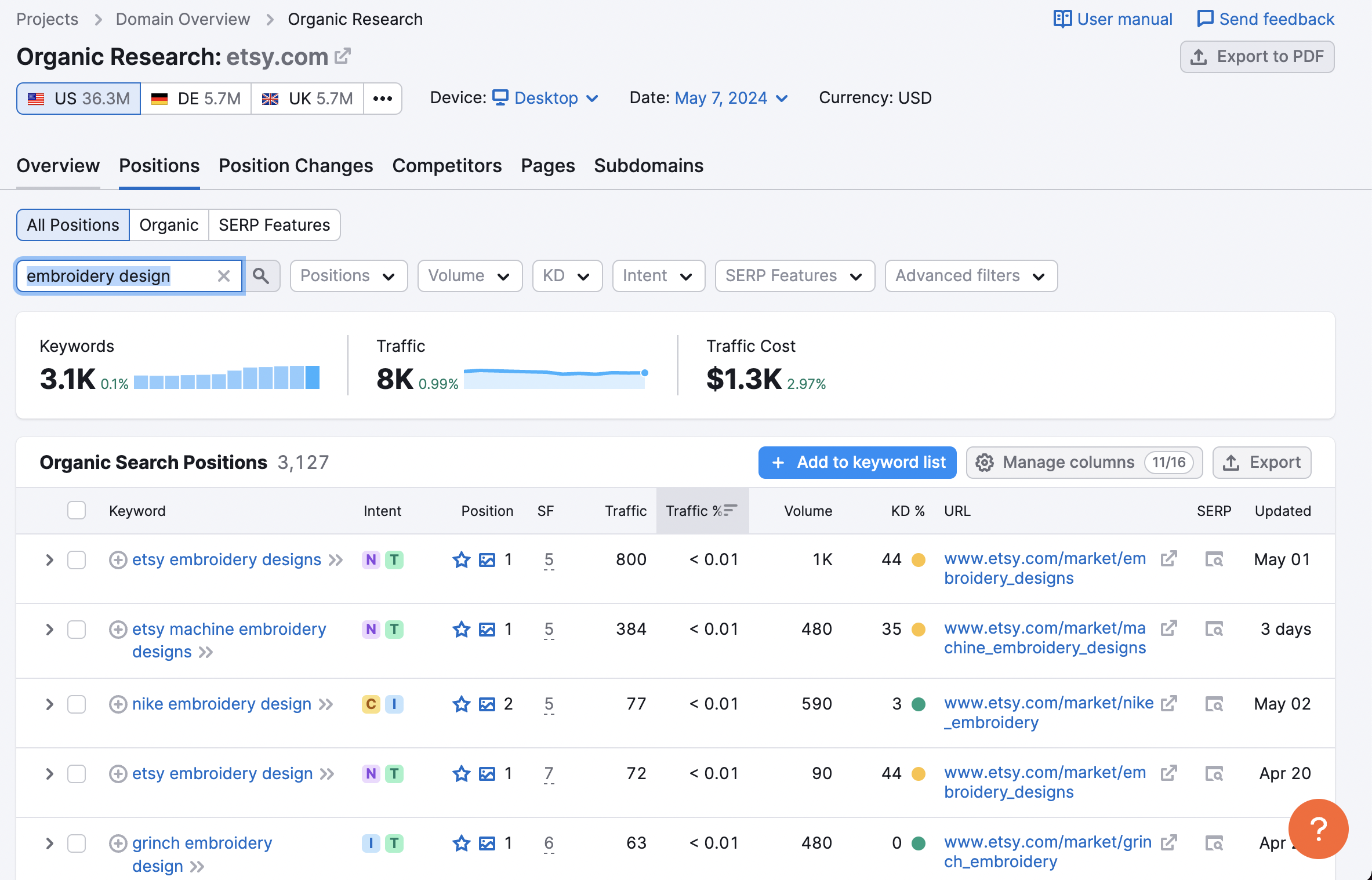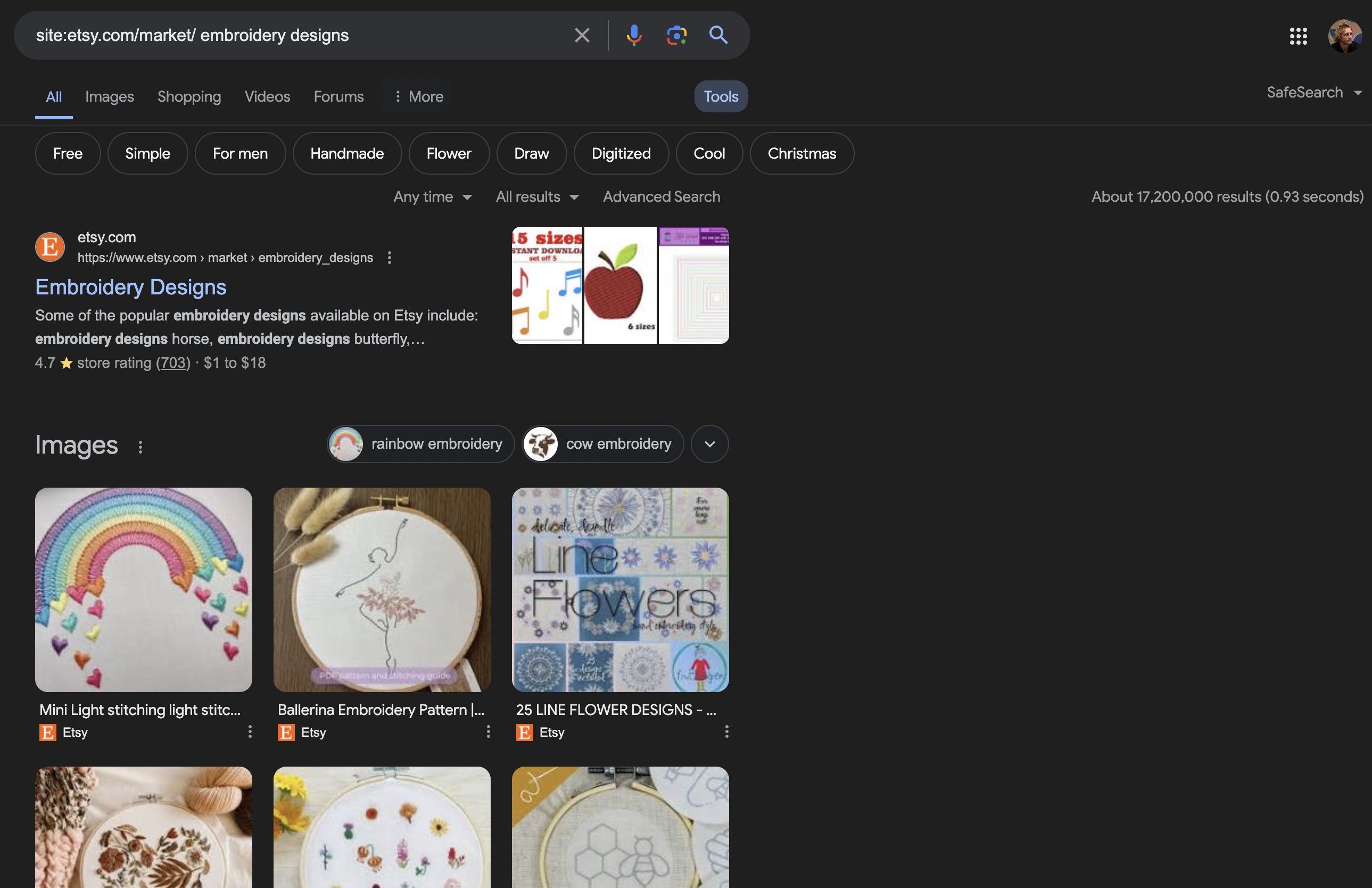
Download your Etsy customer emails and start doing email marketing.
Sign Up FreeAre you passionate about embroidery and have a talent for creating beautiful designs? Selling your embroidery designs on Etsy can be a great way to turn your hobby into a profitable business. With millions of active buyers, Etsy provides a fantastic opportunity to showcase your unique creations and reach a global audience. However, with many other sellers on the platform, it’s crucial to take the right steps to make your shop stand out. In this comprehensive guide, we’ll walk you through everything you need to know to successfully sell embroidery designs on Etsy.
Why Sell Embroidery Designs on Etsy
Etsy, a vibrant marketplace brimming with creativity, shines in the embroidery niche, ranking for a tapestry of 3,100 keywords that draw in enthusiasts and artisans alike.
With an astonishing 17 million pages dedicated to embroidery designs indexed on Google, Etsy presents a labyrinth of opportunities for sellers to showcase their unique creations.
This vast exposure and targeted audience make Etsy an ideal platform for selling embroidery designs, where every stitch and pattern finds its admirer, fueling both passion and profits.


Understanding the Market for Embroidery Designs on Etsy
Before diving into selling on Etsy, it’s important to research the existing market for embroidery designs. Take time to browse through popular embroidery shops and note the types of designs that are in demand, common price points, and how top sellers present their listings[3]. This will give you valuable insights into what buyers are looking for and help you position your own designs effectively.
Some of the most popular embroidery design categories on Etsy include[3][14]:
- Floral and nature-inspired designs
- Holiday and seasonal themes
- Monograms and lettering
- Baby and children’s designs
- Pop culture and fandom art
- Vintage and retro styles
While it’s good to be aware of trends, don’t be afraid to let your unique style shine through. Many buyers on Etsy are seeking one-of-a-kind, original designs that they can’t find anywhere else[3].
Creating Unique and Marketable Embroidery Designs
To be successful on Etsy, your embroidery designs need to be both high-quality and marketable. Start by identifying your niche and developing a cohesive aesthetic for your shop[3]. Consider what makes your designs special, whether it’s a particular style, theme, or technique.
When digitizing your designs, use professional-grade embroidery software to ensure clean, precise stitching[1]. Test your designs on various fabrics and threads to perfect the final result. Remember, the quality of your digital files directly impacts the finished embroidery, so take time to get it right.
As you create designs, keep your target customer in mind. What types of projects might they want to stitch? Consider offering a range of design sizes and file formats to accommodate different embroidery machines and hoop sizes[3].
Setting Up Your Etsy Shop for Success
Once you have a collection of designs ready, it’s time to set up your Etsy shop. Choose a memorable, easy-to-spell shop name that reflects your brand[3]. Develop a consistent visual identity with a logo, banner, and product photography style that appeals to your ideal customer.
When listing your designs, use clear, keyword-rich titles and descriptions to help buyers find your products[1]. Include relevant information such as design size, file format, thread colors, and fabric recommendations. Provide clear, step-by-step instructions for downloading and using the files[4].
Eye-catching product photos are essential for attracting buyers. Use well-lit, high-resolution images that showcase your designs stitched out on actual fabric[1]. Include multiple angles and close-up shots to highlight details and quality. Mockups can also be effective for demonstrating how the design might look on a finished project.
Pricing Your Embroidery Designs
Pricing your designs can be challenging, but it’s important to value your time and expertise appropriately. Consider factors such as the complexity of the design, digitizing time, and the going rates for similar designs on Etsy[1][20].
A common pricing strategy is to set your retail price at 2-3 times the cost of production[20]. For digital designs, this primarily includes your time spent creating and digitizing the file. Don’t undervalue your work – remember, you’re providing a specialized skill and high-quality product.
As you set prices, also factor in Etsy’s fees, including listing fees, transaction fees, and payment processing fees[20]. These costs can add up, so make sure your prices account for them while still allowing for a reasonable profit margin.
Marketing and Promoting Your Etsy Shop
Creating beautiful designs is just the first step – you also need to actively market your shop to potential customers. Start by optimizing your Etsy shop for search with relevant keywords in your shop title, section titles, and product tags[1]. The more effectively you use keywords, the easier it will be for buyers to discover your designs.
Promote your designs on social media platforms like Instagram, Facebook, and Pinterest[1]. Share photos of your designs stitched out, along with helpful tips and inspiration for using them. Engage with the embroidery community by following other designers, participating in stitch-alongs, and joining relevant groups.
Consider offering promotions and discounts to attract new customers and encourage repeat business[15]. Free shipping, percentage-off sales, and bundle deals can be effective strategies. You can also offer a coupon code to buyers who sign up for your email list or follow you on social media.
Providing Excellent Customer Service
Providing top-notch customer service is key to building a positive reputation on Etsy. Respond promptly and professionally to all buyer inquiries, whether it’s a question about a design or an issue with a purchase[1].
Make sure your shop policies are clear and easy to understand, covering topics like payment methods, file delivery, refunds, and copyright[1]. Be upfront about your turnaround time for delivering files after purchase.
If a customer has trouble downloading or using a file, offer helpful troubleshooting advice or even a video tutorial. Going above and beyond to ensure a positive experience can lead to glowing reviews and repeat customers.
Protecting Your Intellectual Property
When selling digital designs online, it’s crucial to protect your intellectual property. Make it clear in your listings and shop policies that your designs are for personal use only and cannot be resold, shared, or used for commercial purposes without permission[18].
Include a copyright notice on your website and in the metadata of your digital files[18]. While not foolproof, this can deter casual copying and serve as evidence of ownership if needed.
If you find someone infringing on your copyrights, contact them directly with a polite but firm request to remove the content[18]. If that fails, you can file a DMCA takedown notice with Etsy or the hosting platform. In extreme cases, legal action may be necessary to enforce your rights.
Growing Your Embroidery Business
As your Etsy shop gains traction, look for ways to expand your reach and income streams. Consider offering additional products like embroidery kits, patterns, or physical stitched items featuring your designs[1]. You could also teach online classes or workshops to share your skills with others.
Collaborating with other Etsy sellers or influencers can expose your designs to new audiences[1]. Look for complementary products like clothing, accessories, or home decor that could showcase your embroidery files in a fresh way.
Stay up-to-date with embroidery trends and technology to keep your designs fresh and relevant. Attend trade shows, join professional organizations, and invest in your ongoing education to continually improve your skills and offerings.
Selling embroidery designs on Etsy takes dedication and hard work, but the rewards of building a successful creative business are well worth it. By developing unique, high-quality designs, optimizing your shop for success, and providing excellent customer service, you can turn your passion for embroidery into a thriving entrepreneurial venture. Happy stitching!
[Word count: 1198]
Citations: [1] https://nancybadillo.com/etsy-embroidery-designs/ [2] https://www.reddit.com/r/legaladvice/comments/qlc4bq/copyright_question_i_often_see_sellers_on_etsy/?rdt=37507 [3] https://etsyhunt.com/tips/how-to-sell-embroidery-designs-on-etsy [4] https://www.reddit.com/r/Etsy/comments/fofix4/looking_for_advice_selling_embroidery_patterns_on/?rdt=54947 [5] https://omlembroidery.com/trade-marks-and-copyright-issues/ [6] https://sewing.patternreview.com/SewingDiscussions/topic/29093 [7] https://www.reddit.com/r/Embroidery/comments/azngvv/starting_to_sell_give_me_tips_please/ [8] https://www.etsy.com/market/selling_embroidery [9] https://royal-present.com/blog/easy-tips-to-sell-more-embroidery-on-etsy/ [10] https://www.efulfillmentservice.com/2023/10/etsy-pricing-strategies/ [11] https://www.etsy.com/market/embroidery_shops [12] https://www.etsy.com/legal/ip/ [13] https://www.etsy.com/seller-handbook/article/1106022743419 [14] https://www.etsy.com/market/embroidery_design [15] https://www.etsy.com/in-en/seller-handbook/article/1200179946791 [16] https://www.etsy.com/forums_thread.php?thread_id=5056229 [17] https://www.youtube.com/watch?v=lcQu2PCYxsc [18] https://www.needlenthread.com/2012/09/copyright-in-embroidery.html [19] https://paperandspark.com/etsy-pricing-formula-how-to-price-for-handmade-part-1/ [20] https://www.etsy.com/seller-handbook/article/745293633907